| Image | Common name | Scientific name | Distribution |
|---|
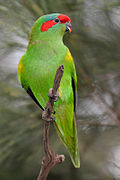 | Musk lorikeet | Trichoglossus concinnus | central east, southeast Australia |
 | Mindanao lorikeet | Trichoglossus johnstoniae | montane forest of Mindanao (southern Philippines) |
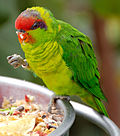 | Iris lorikeet | Trichoglossus iris | Wetar and Timor (east Lesser Sunda Islands) |
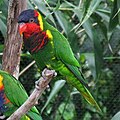 | Ornate lorikeet | Trichoglossus ornatus | Sulawesi and larger satellite islands |
 | Yellow-cheeked lorikeet | Trichoglossus meyeri | montane forest of Sulawesi |
 | Sula lorikeet | Trichoglossus flavoviridis | Sula Islands (Taliabu, Seho, and Mangole) |
 | Blue-streaked lory | Trichoglossus reticulatus | Tanimbar Islands (Arafura Sea) |
 | Blue-eared lory | Trichoglossus semilarvatus | montane forest of Seram (southern Moluccas) |
 | Red lory | Trichoglossus borneus | montane Seram (central east Moluccas) |
 | Black-winged lory | Trichoglossus cyanogenius | islands in Cenderawasih Bay (off northwestern New Guinea) |
 | Red-and-blue lory | Trichoglossus histrio | Sangihe Islands (formerly) and Talaud (north of Sulawesi) |
 | Violet-necked lory | Trichoglossus squamatus | north Moluccas and small islets of Raja Ampat Islands (northwest of New Guinea) |
 | Pohnpei lorikeet | Trichoglossus rubiginosus | lowlands of Pohnpei (eastern Caroline Islands) |
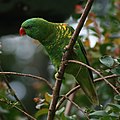 | Scaly-breasted lorikeet | Trichoglossus chlorolepidotus | eastern Australia (Cape York Peninsula, southern Queensland, southward to southern New South Wales coast; introduced Perth, Melbourne, Canberra) |
 | Coconut lorikeet | Trichoglossus haematodus | central, south Moluccas, west New Guinea, east to Bismarck Archipelago, Solomon Islands, Vanuatu and New Caledonia |
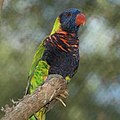 | Biak lorikeet | Trichoglossus rosenbergii | Biak (Cenderawasih Bay, off northwestern New Guinea) |
 | Rainbow lorikeet | Trichoglossus moluccanus | east, southeast Australia and Tasmania |
 | Red-collared lorikeet | Trichoglossus rubritorquis | northwestern Australia (Kimberley region, northern Western Australia, eastward to northwestern Queensland) |
 | Olive-headed lorikeet | Trichoglossus euteles | Lesser Sunda Islands (Timor and adjacent islands from Lomblen to Babar Islands) |
 | Marigold lorikeet | Trichoglossus capistratus | central, east Lesser Sunda Islands |
 | Leaf lorikeet | Trichoglossus weberi | Flores (Lesser Sunda Islands) |
 | Sunset lorikeet | Trichoglossus forsteni | Bali, west Lesser Sunda Islands and (at least formerly) Flores Sea islands south of Sulawesi |
|






















